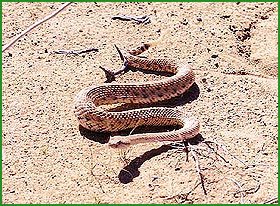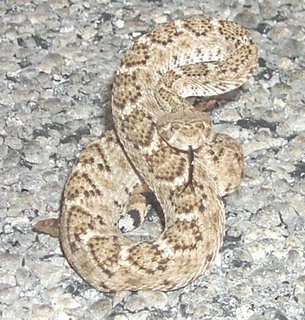
Southern Pacific Rattlesnake
I received a phone call from a friend M, who at the moment is going through a very difficult time in his life, asking me to meet with him for a walk around a local lake so we could talk. M and I are very fond of one another, having known him since kindergarten I arranged to meet him in the parking lot on Saturday morning.
Upon arriving in the parking lot I noticed M sitting at a picnic table looking very sad. I parked, put my dog Rascal on a leash and started walking towards the table. Meeting us at the beginning of the trail we started walking and M started to tell me his tale of woe.
About half way around the lake Rascal started barking and pulling me along trying desperately to go around the corner. His back hairs standing on end, he started growling and continued to try and pull me faster. At this point I looked at M and said “something is up, Rascal is never like this.” So M took the leash from me and stopped Rascal from going any further. At this point we could hear the distinct sound of a rattlesnake. Sure enough he was in the middle of the trail some distance away from us. We immediately turned back around to find a park ranger to deal with the situation.
Since Saturday I have been thinking about all the people in my county as well as the entire state of California who hike, rock climb, campers, gold diggers and spelunkers that need to be aware of the dangers of rattlesnakes.

Colorado Sidewinder
What do rattlesnakes look like? The main features of rattlesnakes include:
- a broad, triangular head on a narrow neck
- folding fangs
- cat's-eye or elliptical pupils instead of round ones
- usually a rattle at the end of the tail (though this may be missing or broken)
What rattlesnakes are found around San Diego?
In my area, the only venomous snakes are rattlesnakes. In the coastal and mountain regions of San Diego County there are three kinds: the Southern Pacific Rattlesnake(Crotalus viridis), the Southwestern Speckled Rattlesnake (C. mitchelli pyrrhus), and the Red Diamond Rattlesnake (C. ruber). In the desert is the Colorado Desert Sidewinder (C. cerastes). Unverified reports have been made of the Western diamondback rattlesnake (C. atrox), which is known from neighboring Imperial County.
Red Diamond Rattlesnake
What should you do if you come across a rattlesnake?
Don't let your fear keep you from enjoying the outdoors. For all their fearsome reputation, rattlesnakes are quite shy and do not come after people. They will strike only in self-defense. If you can learn to behave in a way that does not frighten snakes, you will greatly reduce your chances of a confrontation. Here are some common-sense suggestions:
If you will be hiking in a remote area, do not hike alone.
Always wear sturdy shoes (not sandals, jellies or flip-flops) with socks when you are out walking in grassy or rocky areas. Don't allow children to run outside barefoot or in silly shoes.
Don't ever put your hands or feet anywhere you aren't looking. Don't put your hands on rocks or branches over your head, and don't put your hands or feet under anything.
Snakes usually pick up the vibrations of feet and walking sticks and get out of the way, but sometimes do not.
Walk, don't run, especially in unfamiliar, grassy, brushy, or rocky areas. Never let a dog run loose; always keep a dog leashed no matter how good it normally is. Running means that you may surprise a snake (and they don't like surprises), and dogs are fascinated with rattlesnakes and will not leave them alone. A large snake can easily kill a small dog.
If you have to turn over a rock or log, turn it toward you, keeping your hands on your side of the log, not reaching over it. If it's in your path, walk around it; don't step over it (a snake might be lying on the other side).
Don't try to catch snakes. This may sound obvious, but most snakebites happen this way. Wild snakes do not make good pets and should never be killed. The only good reason to try to catch a wild snake is to move it out of harm's way to a safer place, and this should only be done by someone with knowledge and training. Don't tease snakes by throwing rocks or cornering them.

Western Diamond Back
What do I do if I do get bitten by a rattlesnake? Or if my child does? Or my dog does?
Do not panic. First, take a deep breath. Let your adrenaline rush subside a little before you act. A rattlesnake bite will leave two well-defined puncture marks and there will be an immediate, lasting pain. If you are unsure if the snake is a poisonous species, treat it as a medical emergency anyway.
If you have been bitten by a rattlesnake, it is important to get help as soon as possible. Call 911 for medical assistance. The best treatment for a rattlesnake bite is to seek medical treatment immediately. Get to a hospital emergency room as soon as possible.
If someone else has been bitten, keep that person calm and transport them to the hospital immediately. Call 911 if the medical condition of the person is severe. Don't chase the snake.
The antivenin treatment for a rattlesnake bite does not require knowing what species of rattlesnake it is. In the southern California area, the only poisonous snakes are rattlesnakes. Therefore, the emergency medical staff should be able to identify the characteristics of a bite without knowing exactly what kind of snake it is.
DO NOT DO ANY OF THE FOLLOWING
Do not apply a tight, constricting tourniquet.
Do not cut the bite area.
Do not ice the bite area.
Do not attempt to suck out the venom with your mouth.
Do not give alcohol to the bitten person.
Seek medical attention immediately. Visit the California Poison Control Center at San Diego's UCSD Medical Center for further information.
If this keeps someone or their animals from being bitten, it will make my day! Anyone out there ever been bitten by a rattlesnake? I would love to read your story.
N Posted by Rain at 6/27/2006 01:13:00 AM


posted at 6:57 AM
My brother in law was bitten by a copperhead. They had to filet his arm in several places because it swelled up so badly.

posted at 1:38 PM
I don't like snakes. I realize they do a good service by keeping down the vermin, but I don't like those varmits, I don't!

Rain posted at 7:18 AM
Jules, I have heard that copperheads are nasty snakes. Just reading "filet his arm" gives me the willys. If given a choice between dying or being cut open, hands down, cut me open! Glad to know that he survived =)
tech, Five years ago, after the fires in Southern California there was much concern over our local wildlife that included snakes. In fact a friend of mine's house was one of the few that did not burn to the ground, was over run by vermin. The American Red Cross put her in touch with a local snake dealer, and he released non poisonous snakes on the property to help control the vermin.

posted at 9:59 PM
I grew up in Northern California - so I know all about rattlers. I used to backpack on horseback up by Grass Valley and beyond. Rattlers really like to sun themselves on all of those big, flat rocks. Huge suckers too. The horses would spook something fierce if we disturbed one. I remember hiking up a bit to a spectacular view - and watching one monstrous fucker glide on by just a couple of feet in front of me. Rule of thumb: They'll leave your ass alone if you don’t threaten them. One of my friends used to catch 'em and roast 'em for dinner - but I always preferred to eat the fish I'd just caught. I don’t do snake. We have lots of poisonous snakes Down South - I had to have my property sulphered, actually.



« Home


![]()
![]()




